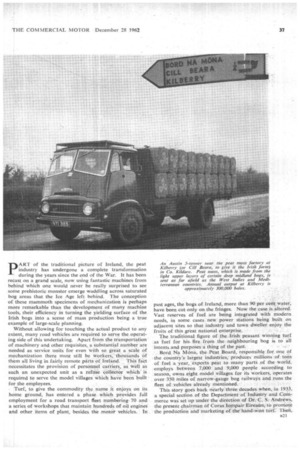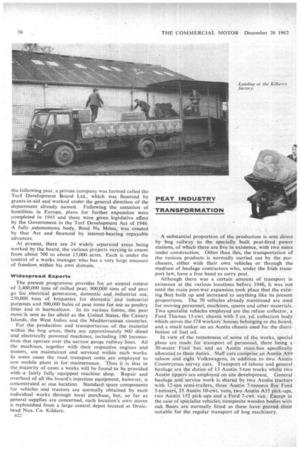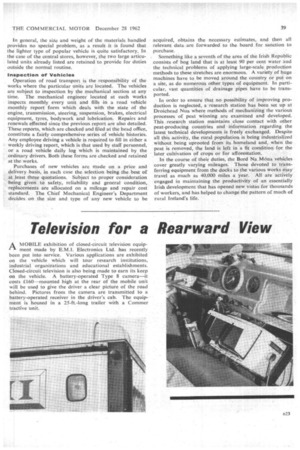ROAD TRANSPORT'S SHARE IN
Page 38

Page 39

Page 40

Page 41

If you've noticed an error in this article please click here to report it so we can fix it.
Peat Industry Transformatior
Essential link-up for Bord na Mona scheme provided by modern fleet. Large-scale mechanization speeds production pART of the traditional picture of Ireland, the peat industry has undergone a complete transformation during the years since the end of the War. It has been recast on a grand scale, now using fantastic machines from behind which one would never be really surprised to see some prehistoric monster emerge waddling across saturated bog areas that the Ice Age left behind. The conception of these mammoth specimens of mechanization is perhaps more remarkable than the development of many machine tools, their efficiency in turning the yielding surface of the Irish bogs into a scene of mass production being a true example of large-scale planning.
Without allowing for touching the actual product to any extent, many road vehicles are required to serve the. operating side of this undertaking. Apart from the transportation of machinery and other requisites, a substantial number are needed as service units for even With so great a scale of mechanization there must stilt be workers, thousands of them all living in fairly remote parts of Ireland. This fact necessitates the provision of personnel carriers, as well as such an unexpected unit as a refuse collector 'which is required to serve the model villages which have been built for the employees.
Turf, to give the commodity the name it enjoys on its home ground, has entered a phase which provides full employment for a road transport fleet numbering 70 and a series of workshops that maintain hundreds of oil engines and other items of plant, besides the motor vehicles. In past ages, the bogs of Ireland, more than 90.per cent water, have been cut only on the fringes. Now the case is altered. Vast reserves of fuel are being integrated with modern needs, in some cases new power stations being built on adjacent sites so that industry and town dweller enjoy the fruits of this great national enterprise.
The traditional figure of the Irish peasant winning turf as fuel for his fire from the neighbouring bog is to all intents and purposes a thing of the past.
Bord Na Mina, the Peat Board responsible for one of the country'slargest industries, produces millions of tons of fuel a -year, exports peat to many parts of the world. employs between 7,000 and 9,000 people according to . season, owns eight model villages for its workers, operates over 350 Miles of narrow-gauge bog railways and runs the fleet of :vehicles already mentioned.
This story goes back nearly three decades when, in 1933, a special section of the Department of Industry and Commerce was set up under the direction a Dr. C. S. Andrews, the present chairman of Coras Impair Eireann, to pi omoie
the production and marketing of the' hand-won turf. Then,
the blowing year, a private company was formed called the Turf Development Board Ltd., which was financed by grants-in-aid and worked under the general direction of the department already named. Following the cessation of hostilities in Europe, plans for further expansion were completed in 1945 and these were given legislative effect by the Government in the Turf Development Act of 1946. A fully ,autonomous body, Borcl Na Mona, was created by that Act and financed by interest-bearing repayable advances.
At present, there are 24 widely separated areas being worked by the board, the various projects varying in extent from about 700 to about 13,000 acres. Each is under the "control of a works manager who has a very large measure of freedom within his own domain. .
Widespread Experts
The present programme provides for, an annual output of 3,400,000 tons of .milled peat; 900;000 tons of sod peat go for electrical generation, domestic, and.. industrial use, 250,000 tons of briquettes for .domestic and industrial purposes and 500,000 bales of peat moss for use as poultry _litter and in horticulture. In its various forms, the peat moss'is sent as far afield as the United States,the Canary Islands, the West Indies and the Mediterranean countries.
For, the production and transportation of. the material within the bog areas, there are approximately 900 diesel and electrically powered machines, including 190 locomo.tives that operate over the narrow gauge railway lines. All the machines, together with their respective engines and motors, are maintained and serviced within each works. In some cases the road transport units are . employed to tow mobile plant in formaintenance. Thus it is that in thejnajority of cases a works will be found to be provided witfr. a fairly fully equipped machine shop. Repair and overhaul of all the board's injection equipment, however, is concentrated at one location. Standard spare components for vehicles and tractors are normally obtained by each individual works through local purchase, but, so far as general supplies are concerned, each location's own stores is replenished from a large central depot located at Droichead Nua, Co. Kildare.
B22' A substantial proportion of the production is sent direct by bog railway to the specially built peat-fired power stations, of which there are five in existence, with two more under construction. Other than this, the transportation of the various products is normally carried out by the purchasers, either with their own vehicles or through the medium of haulage contractors who, under the Irish transport law, have a free hand to carry peat.
Although there was a certain amount of transport in existence at the various locations before 1946, it was not until the main post-war expansion took place that the existing fleet built up and increased to anything like its present proportions. The 70 vehicles already mentioned are used for moving personnel, machines, spares and other materials. Two specialist vehicles employed are the refuse collector, a Ford Thames 15-cwt. chassis with 3 Cu. yd. collection body which serves the 578 workers' houses belonging to the board, and a small tanker on an Austin chassis used for the distribution of fuel oil.
In view of the remoteness of some of the works, special plans are, made for transport of personnel, there being a 30-seater. Ford bus and an Austin mini-bus specifically allocated:to these duties. Staff cars corriprise.an Austin A99 saloon and 'eight Volkswagens, in addition to two Austin Countryman survey cars. Transport of labour and general hauIage.are the duties of 13 Austin 5-ton trucks whilst two Austin tippers are employed on Site development. General haulage and service work is shared by two Austin tractors with 12-ton semi-trailers, three Austin 7-tonners five Ford 5-tonneri, 25 Austin 10-cwt, vans, two Austin A55 pick-ups, two AuStin 152 pick-ups and a Ford 7-cwt. van. Except in the case at specialist vehicles, composite wooden bodies with oak flobrs are: normally fitted as these have proved Most suitable for the regular transport of bog machinery.
In general, the size and weight of the materials handled provides no special problem, as a result it is found that the lighter type of popular vehicle is quite satisfactory. In the case of the central stores, however, the two large articulated units already listed are retained to provide for duties outside the normal routine.
Inspection of Vehicles
Operation of road transport is the responsibility of the works where the particular units are located. The vehicles are subject to inspection by the mechanical section at any time. The mechanical engineer located at each works inspects monthly every unit and fills in a road vehicle monthly report form which deals with the state of the engine, transmission, steering, suspension, brakes, electrical equipment, tyres, bodywork and lubrication. Repairs and renewals effected since the previous report are also detailed. These reports, which are checked and filed at the head office, constitute a fairly comprehensive series of vehicle histories. Any employee driving a vehicle is required to fill in either a weekly driving report, which is that used by staff personnel, or a road vehicle daily log which is maintained by the ordinary drivers. Both 'these forms are checked and retained at the works.
Purchases of new vehicles are made on a price and delivery basis, in each case the selection being the best of at least three quotations. Subject to proper consideration being given to safety, reliability and general condition, replacements are allocated on a mileage and repair cost standard. The Chief Mechanical Engineer's Department decides on the size and type of any new vehicle to be acquired, obtains the necessary estimates, and then all relevant data are forwarded to the board for sanction to purchase.
Something like a seventh of the area of the Irish Republic consists of bog land that is at least 90 per cent water and the technical problems of applying large-scale production methods to these stretches are enormous. A variety of huge machines have to be moved around the country or put on a site, as do numerous other types of equipment. In particular, vast quantities of drainage pipes have to be transported.
In order to ensure that no possibility of improving production is neglected, a research station has been set up at Droichead Nua where methods of mechanizing the various processes of peat winning are examined and developed. This research station maintains close contact with other peat-producing countries and information regarding the latest technical developments is freely exchanged. Despite all this activity, the rural population is being industrialized without being uprooted from its homeland and when the peat is removed, the land is left in a fit condition for the later cultivation of crops or for afforestation.
In the course of their duties, the Bord Na Mona vehicles cover greatly varying mileages. Those devoted to transferring equipment from the docks to the various works may travel as much as 40,000 miles a year. All are actively engaged in maintaining the productivity of an essentially Irish development that has opened new vistas for thousands of workers, and has helped to change the pattern of much of rural Ireland's life.




















































































